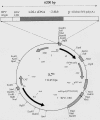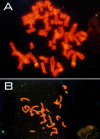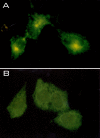A bovine papillomavirus-1 based vector restores the function of the low-density lipoprotein receptor in the receptor-deficient CHO-ldlA7 cell line
- PMID: 11967145
- PMCID: PMC111063
- DOI: 10.1186/1471-2199-3-5
A bovine papillomavirus-1 based vector restores the function of the low-density lipoprotein receptor in the receptor-deficient CHO-ldlA7 cell line
Erratum in
-
A bovine papillomavirus-1 based vector restores the function of the low-density lipoprotein receptor in the receptor-deficient CHO-ldlA7 cell line: Correction.BMC Mol Biol. 2002 Jun 11;3:9. doi: 10.1186/1471-2199-3-9. Epub 2002 Jun 11. BMC Mol Biol. 2002. PMID: 12060487 Free PMC article. No abstract available.
Abstract
Background: The rationale of using bovine papillomavirus-1 (BPV-1) derived vectors in gene therapy protocols lies in their episomal maintenance at intermediate to high copy number, and stable, high-level expression of the gene products. We constructed the BPV-1 based vector harbouring the human low-density lipoprotein receptor (LDLR) gene cDNA and tested its ability to restore the function of the LDLR in the receptor-deficient cell line CHO-ldlA7.
Results: The introduced vector p3.7LDL produced functionally active LDL receptors in the receptor-deficient cell line CHO-ldlA7 during the 32-week period of observation as determined by the internalisation assay with the labelled LDL particles.
Conclusion: Bovine papillomavirus type-1 (BPV-1)-derived vectors could be suitable for gene therapy due to their episomal maintenance at intermediate to high copy number and stable, high-level expression of the gene products. The constructed BPV-1 based vector p3.7LDL produced functionally active LDL receptors in the LDLR-deficient cell line CHO-ldlA7 during the 32-week period of observation. In vivo experiments should reveal, whether 1-5% transfection efficiency obtained in the current work is sufficient to bring about detectable and clinically significant lowering of the amount of circulating LDL cholesterol particles.
Figures







Similar articles
-
A bovine papillomavirus-1 based vector restores the function of the low-density lipoprotein receptor in the receptor-deficient CHO-ldlA7 cell line: Correction.BMC Mol Biol. 2002 Jun 11;3:9. doi: 10.1186/1471-2199-3-9. Epub 2002 Jun 11. BMC Mol Biol. 2002. PMID: 12060487 Free PMC article. No abstract available.
-
Adenovirus-mediated gene transfer of human lipoprotein lipase ameliorates the hyperlipidemias associated with apolipoprotein E and LDL receptor deficiencies in mice.Hum Gene Ther. 1997 Nov 1;8(16):1921-33. doi: 10.1089/hum.1997.8.16-1921. Hum Gene Ther. 1997. PMID: 9382958
-
Construction of a novel bovine papillomavirus vector without detectable transforming activity suitable for gene transfer.Hum Gene Ther. 1995 Mar;6(3):325-33. doi: 10.1089/hum.1995.6.3-325. Hum Gene Ther. 1995. PMID: 7779916
-
Infectious delivery of a 135-kb LDLR genomic locus leads to regulated complementation of low-density lipoprotein receptor deficiency in human cells.Mol Ther. 2003 May;7(5 Pt 1):604-12. doi: 10.1016/s1525-0016(03)00060-1. Mol Ther. 2003. PMID: 12718903
-
Homozygous familial hypercholesterolaemia: update on management.Paediatr Int Child Health. 2016 Nov;36(4):243-247. doi: 10.1080/20469047.2016.1246640. Paediatr Int Child Health. 2016. PMID: 27967828 Review.
Cited by
-
A bovine papillomavirus-1 based vector restores the function of the low-density lipoprotein receptor in the receptor-deficient CHO-ldlA7 cell line: Correction.BMC Mol Biol. 2002 Jun 11;3:9. doi: 10.1186/1471-2199-3-9. Epub 2002 Jun 11. BMC Mol Biol. 2002. PMID: 12060487 Free PMC article. No abstract available.
References
-
- Goldstein JL, Brown MS. Familial hypercholesterolemia. In: Scriver CR, Beaudet L, Sly WS, Valle D, editor. Metabolic Basis of Inherited Disease. New York: McGraw Hill; 1989. pp. 1215–1250.
-
- Zwiener RJ, Uauy R, Petruska ML, Huet BA. Low-density lipoprotein apheresis as long-term treatment for children with homozygous familial hypercholesterolemia. J Pediatr. 1995;126:728–735. - PubMed
-
- Grossman M, Raper SE, Kozarsky K, Stein EA, Engelhardt JF, Muller D, Lupien PJ, Wilson JM. Successful ex vivo gene therapy directed to liver in a patient with familial hypercholesterolaemia. Nat Genet. 1994;6:335–341. - PubMed
LinkOut - more resources
Full Text Sources

